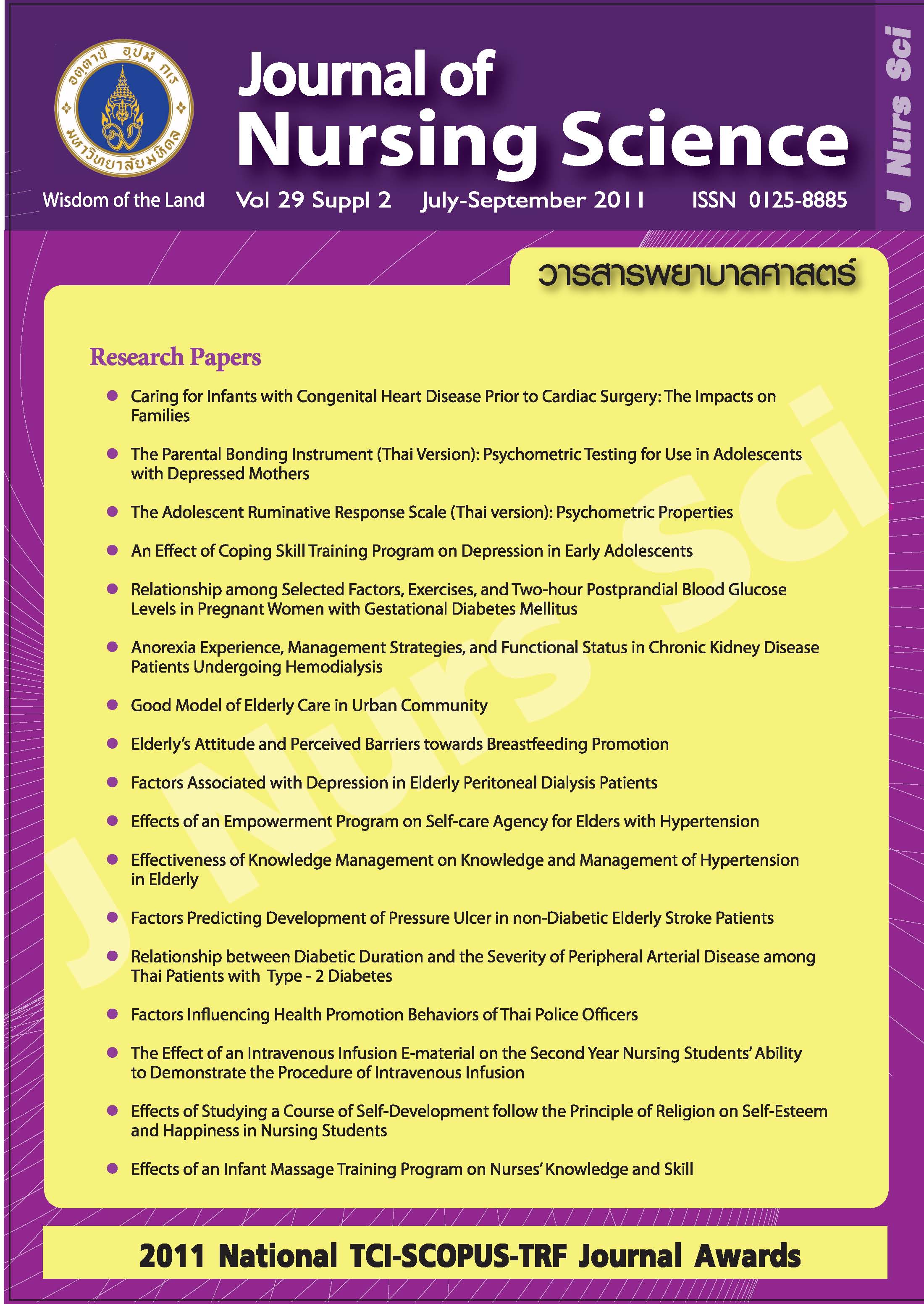The Parental Bonding Instrument (Thai Version): Psychometric Testing for Use in Adolescents with Depressed Mothers
Main Article Content
บทคัดย่อ
Purpose: To test for reliability and construct validity of theParental Bonding Instrument (PBI) – Thai version for use inadolescents with depressed mothers.
Design: Methodological research.
Methods: Data from a previous study of 460 adolescents withdepressed mothers were used to assess construct validity byconducting a confirmatory factor analysis through LISREL,and reliability by calculating Cronbach’s alpha coefficient.
Main findings: The analysis yielded satisfactory results ofchi-square = 302.30, df = 266, p-value = 0.062, RMSEA= 0.017, GFI = 0.96, AGFI = 0.93 The results support that thePBI consists of two components: caring and overprotection.Cronbach’s alpha coefficients were 0.88 for caring and 0.80 foroverprotection components.
Conclusion and recommendations: Findings indicate thatthe PBI is a reliable measure for use in Thai adolescents withdepressed mothers. This instrument will be of great benefitfor use as an assessment tool for both research and clinicalpurposes.
Article Details
ลิขสิทธิ์: วารสารพยาบาลศาสตร์เป็นเจ้าของลิขสิทธิ์ในการเผยแพร่ผลงานที่ตีพิมพ์ ห้ามผู้ใดนำบทความที่ได้รับการตีพิมพ์ในวารสารพยาบาลศาสตร์ไปเผยแพร่ในลักษณะต่างๆ ดังต่อไปนี้ การส่งบทความไปตีพิมพ์เผยแพร่ที่อื่น การนำบทความเผยแพร่ออนไลน์ การถ่ายเอกสารบทความเพื่อกิจกรรมที่ไม่ใช่การเรียนการสอน ยกเว้นเสียแต่ได้รับอนุญาตจากวารสารพยาบาลศาสตร์

Disclaimer: เนื้อหาบทความหรือข้อคิดเห็นใดๆ ในวารสารพยาบาลศาสตร์ ถือเป็นความรับผิดชอบของผู้เขียน กองบรรณาธิการไม่จำเป็นต้องเห็นด้วยและไม่มีส่วนรับผิดชอบแต่อย่างใด
เอกสารอ้างอิง
Yoo HI, Kim BN, Shin MS, Cho SC, Hong KE. Parental attachment and its impact on the development of psychiatric manifestations in school-aged children. Psychopathology. 2006;39(4):165-74.
Enns MW, Cox BJ, Clara I. Parental bonding and adult psychopathology: results from the US National Comorbidity Survey. Psychol Med. 2002;32(6):997-1008.
Grotmol Kjersti S, Ekeberg O, Finset A, Gude T, Moum T, Vaglum P, Tyssen R. Parental bonding and self-esteem as predictors of severe depressive symptoms: A 10-year
follow-up study of Norwegian physicians. J Nerv Ment Dis. 2010;198(1):22-7.
Freudenstein O, Zohar A, Apter A, Shoval G, Weizman A, Zalsman G. Parental bonding in severely suicidal inpatients. Europian Psychiatry Doi: 10.1016/j.eurpsy 2011.01.006.
Charoensuk S. Factors influencing depression in Thai adolescents. (Dissertation). Kentucky, University of Kentucky; 2005. 134 p.
Vongsirimas N, Sitthimongkol Y, Beeber L, Wiratchai N, Sangon S. Relationship among maternal depressive symptoms, gender differences and depressive symptoms in Thai adolescents. Thai J Nurs Res. 2009;13(3):
-98.
Hammen C, Brennan PA. Severity, chronicity, and timing of maternal depression and risk for adolescent offspring diagnosis in a community sample. Arch Gen Psychiat. 2003;60:253-8.
Slater MA, Power TG. Multidimensional assessment of parenting in single-parent families. In: Vincent JP, editor. Advances in family intervention, assessment, and theory.
Greenwich, CT: JAI Press; 1987. P.197-228.
Schaefer ES. A configurational analysis of children’s reports of parent behavior. J Consult Psychol. 1965;29(6):552-7.
Parker G, Tupling H, Brown LB. A parenting bonding instrument. Br J Med Psychol. 1979;52:1-10.
Parker G. The Parental Bonding Instrument. A decade of research. Soc Psychiatry Psychiatr Epidemiol. 1990;25:281-2.
Wilhelm K, Niven H, Parker G, Hadzi-Pavlovic D. The stability of the Parental Bonding Instrument over a 20-year period. Psychol Med. 2004;35:387-93.
Kay W, Niven H, Parker G, Hadzi-Pavlovic D. The stability of the Parental Bonding Instrument over a 20-year period. Psychol Med. 2005;35(3):387-93.
Murphy E, Wickramaratne P, Weissman M. The stability of parental bonding reports: A 20-year follow-up. J Affect Disorders. 2010; 125:307-15.
Gomez-Beneyto M, Pedros A, Tomas A, Aguilar K, Leal C. Psychometric properties of the parental bonding instrument in a Spanish sample. Soc Psychiatr Epidemiol.
;28(5):252-5.
Uji M, Tanaka N., Shono M, Kitamura T. Factorial structure of the Parental Bonding Instruments (PBI) in Japan: a study of cultural, developmental, and gender
influences. Child Psychiat Hum D. 2006;37: 115-32.
Mohr S, Preisig M, Fenton BT, Ferrero F. Validity of the French version of the parental bonding instrument in adults. Pers Indiv Differ. 1999;25(6):1065-74.
Terra L, Hauck S, Schestatsky S, Fillipon AP, Sanchez P, Hirakata V, Ceitlin LH. Confirmatory factor analysis of the Parental Bonding Instrument in a Brazilian female population. Aust New Zeal J Psychiat. 2009;43(4):348-54.
Qadir F, Stewart R, Khan M, Prince M. The validity of the Parental Bonding Instrument as a measure of maternal bonding among young Pakistani women. Soc Psychiatr Epidemiol. 2005;40(4): 276-82.
Liu J, Li L, Fang F. Psychometric properties of the Chinese version of the Parental Bonding Instrument. Int J Nurs Stud. 2011;48:582-9.
Murphy E, Brewin CR, Silka L. The assessment of parenting using the Parental Bonding Instrument: two or three factors? Psychol Med. 1997;27:333-42.
Hair JF, Anderson RE, Tatham RL, Black WC. Multivariate data analysis. NJ: Prentice- Hall; 2005.
Joreskog KG, Sorbom D. LISREL 8 user’s reference guide. Chicago: Scientific Software International; 1996.
Nunnally JC, Bernstein IH. Psychometric theory. New York: McGraw-Hill; 1994.


